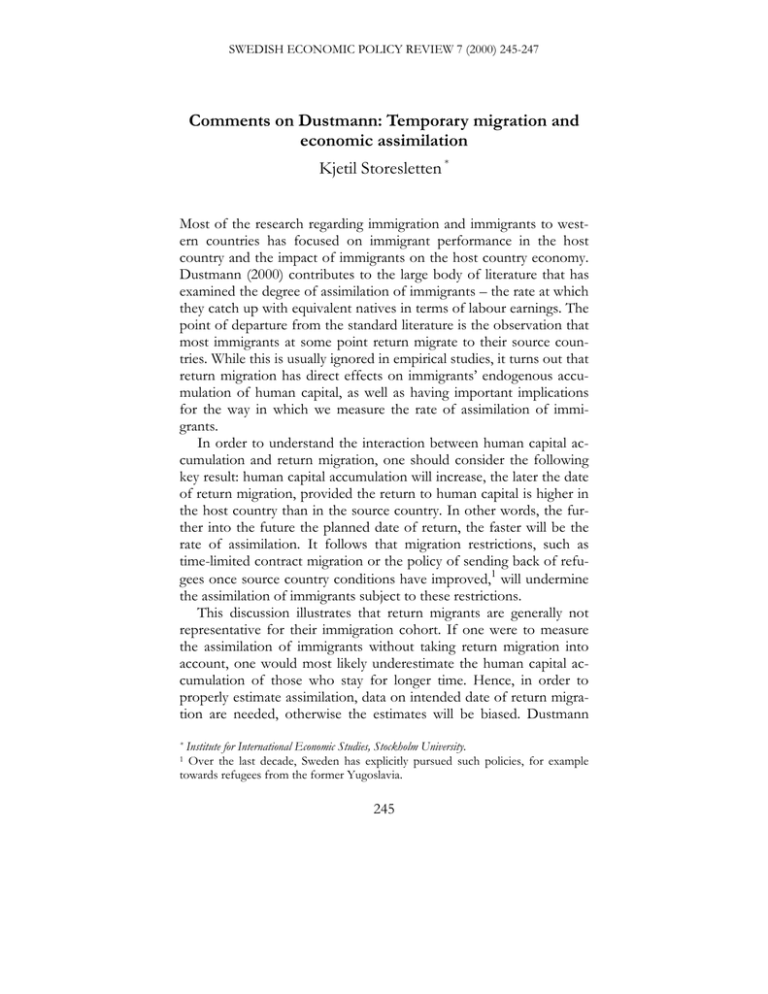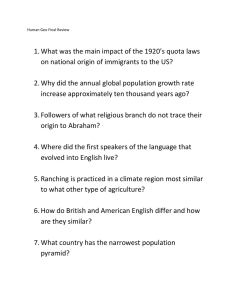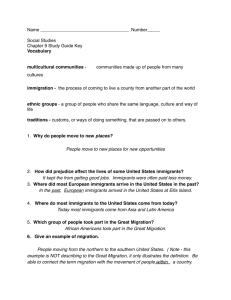Comments on Dustmann: Temporary migration and economic assimilation Kjetil Storesletten
advertisement

SWEDISH ECONOMIC POLICY REVIEW 7 (2000) 245-247 Comments on Dustmann: Temporary migration and economic assimilation Kjetil Storesletten * Most of the research regarding immigration and immigrants to western countries has focused on immigrant performance in the host country and the impact of immigrants on the host country economy. Dustmann (2000) contributes to the large body of literature that has examined the degree of assimilation of immigrants – the rate at which they catch up with equivalent natives in terms of labour earnings. The point of departure from the standard literature is the observation that most immigrants at some point return migrate to their source countries. While this is usually ignored in empirical studies, it turns out that return migration has direct effects on immigrants’ endogenous accumulation of human capital, as well as having important implications for the way in which we measure the rate of assimilation of immigrants. In order to understand the interaction between human capital accumulation and return migration, one should consider the following key result: human capital accumulation will increase, the later the date of return migration, provided the return to human capital is higher in the host country than in the source country. In other words, the further into the future the planned date of return, the faster will be the rate of assimilation. It follows that migration restrictions, such as time-limited contract migration or the policy of sending back of refugees once source country conditions have improved,1 will undermine the assimilation of immigrants subject to these restrictions. This discussion illustrates that return migrants are generally not representative for their immigration cohort. If one were to measure the assimilation of immigrants without taking return migration into account, one would most likely underestimate the human capital accumulation of those who stay for longer time. Hence, in order to properly estimate assimilation, data on intended date of return migration are needed, otherwise the estimates will be biased. Dustmann Institute for International Economic Studies, Stockholm University. Over the last decade, Sweden has explicitly pursued such policies, for example towards refugees from the former Yugoslavia. * 1 245 COMMENTS ON DUSTMANN, Kjetil Storesletten accounts for the various econometric problems that arise, and sketches the possible solution, namely the properties of the instruments one would have to use in order to get consistent estimates of immigrant assimilation. Perhaps the key message is that properly accounting for return migration might indeed alter our views on how fast immigrants assimilate. But why should economists and policy makers really care about understanding the assimilation process of immigrants? There is a presumption that assimilation is important. But why should assimilation matter for the welfare of native inhabitants in the host country? One obvious channel though which immigrants have a significant effect on the welfare of native inhabitants is via fiscal policy.2 In particular, in Storesletten (1998, 2000) I show that the factors Dustmann (2000) focuses on indeed turn out to be quantitatively important in terms of their impact on public coffers. These can be summarised as follows: As discussed above, return migration interacts with human capital accumulation. Higher human capital improves the impact on public coffers, because highly-skilled immigrants obtain higher earnings, and therefore contribute more taxes. The timing of return migration has a direct effect on the fiscal outcome, even when ignoring the endogenous effects on assimilation. For instance, the age at which return migration maximises government revenues is at retirement. Finally, the fiscal gain decreases as the return migration for highskilled working age immigrants increases, because their remaining work life represents a large net transfer to the government, even when taking into account the cost of retirement. Similarly, the fiscal gain increases (or, alternatively, the fiscal loss decreases) as the rate of return migration for retirees, children and low-skilled immigrants is increased. Several policy implications can be derived. First, as argued above, the government can unambiguously improve the fiscal outcome by inducing high-skilled immigrants to plan to stay longer. One way to facilitate this is to adopt a liberal attitude towards granting working permits, such as granting foreign students citizenship automatically A large body of literature has explored the empirical effects of immigration on native wages or employment. The consensus is that these effects are quantitatively small and have minuscule implications for welfare (Borjas, 1994; and Ben-Gad, 2000). 2 246 COMMENTS ON DUSTMANN, Kjetil Storesletten upon graduation, or making it easier for domestic firms to hire foreigners. Second, one can unambiguously improve fiscal outcome by inducing retired immigrants to return-migrate. To this end, one might consider providing return stipends for retirees and simplifying the procedure for collecting pension benefits from the host country after returning to the country or origin. Finally, the fiscal effect of inducing lower return migration for low-skilled immigrants is ambiguous. Having costly immigrants stay longer in the host country has a direct negative effect on the fiscal outcome. This effect is mitigated, however, by the fact that a later planned return will stimulate human capital accumulation by immigrants. The main point at issue here is that human capital accumulation in general, and return migration in particular, should be taken into explicit account when formulating immigration policy. References Ben-Gad, M. (2000), An Analysis of Immigration in a Dynamic Macroeconomic Framework, Mimeo, University of Houston. Borjas, G.J. (1994), The Economics of Immigration, Journal of Economic Literature 32. Dustmann, C. (2000), Temporary Migration and Economic Assimilation, Swedish Economic Policy Review, this issue. Storesletten, K. (2000), Sustaining Fiscal Policy through Immigration, Journal of Political Economy 108. Storesletten, K. (1998), Fiscal Implications of Immigration to Sweden—a Net Present Value Calculation, Mimeo, Institute for International Economic Studies, Stockholm University. 247







